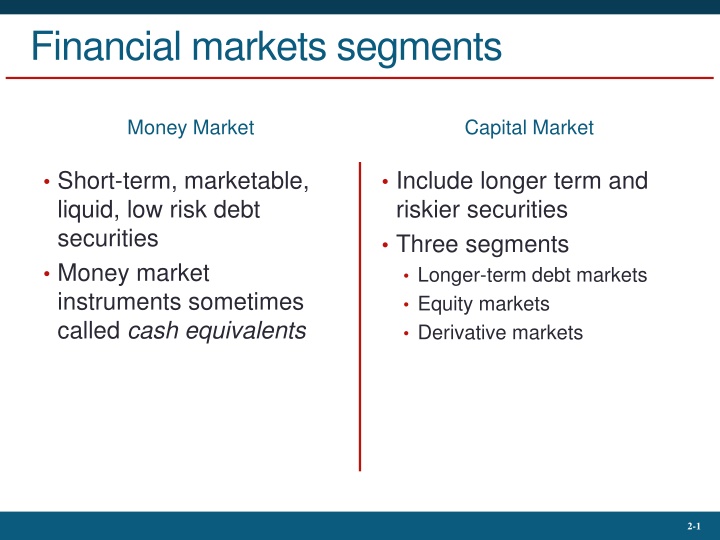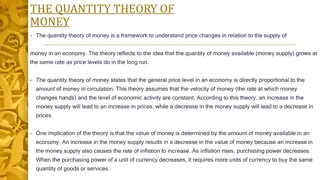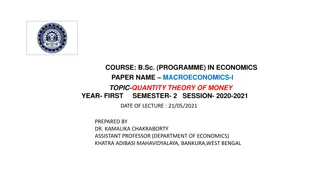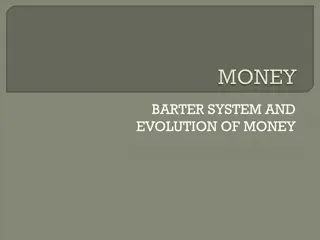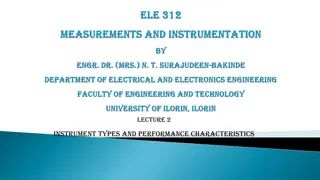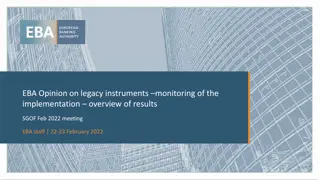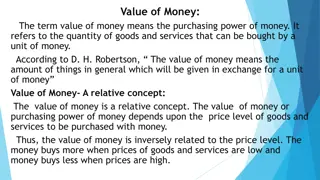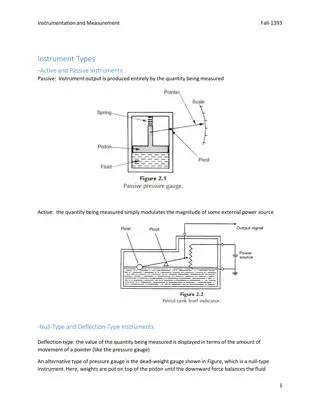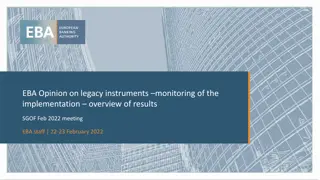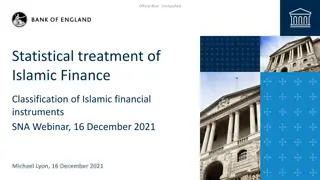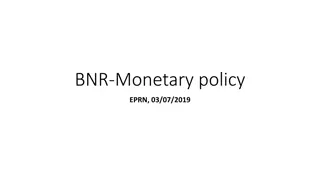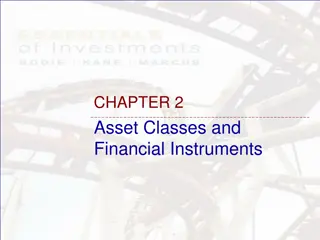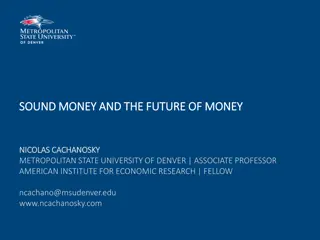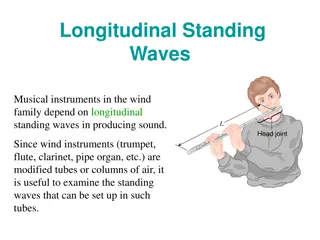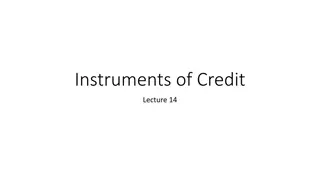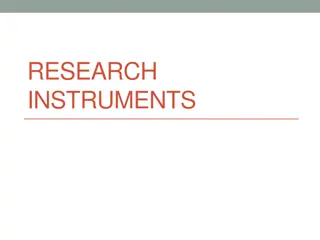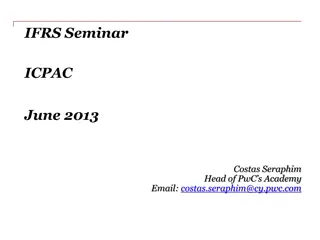Overview of Money Market Instruments
This detailed content provides an insight into various money market instruments such as Treasury Bills, Certificates of Deposit, Commercial Paper, Bankers' Acceptances, and Eurodollars. Each instrument's features including issuer, denomination, maturity, liquidity, default risk, interest type, and taxation are discussed. The content also covers assets like Federal Funds, LIBOR, and Brokers' Funds, giving a comprehensive understanding of the money market.
Download Presentation

Please find below an Image/Link to download the presentation.
The content on the website is provided AS IS for your information and personal use only. It may not be sold, licensed, or shared on other websites without obtaining consent from the author.If you encounter any issues during the download, it is possible that the publisher has removed the file from their server.
You are allowed to download the files provided on this website for personal or commercial use, subject to the condition that they are used lawfully. All files are the property of their respective owners.
The content on the website is provided AS IS for your information and personal use only. It may not be sold, licensed, or shared on other websites without obtaining consent from the author.
E N D
Presentation Transcript
Financial markets segments Money Market Capital Market Short-term, marketable, liquid, low risk debt securities Money market instruments sometimes called cash equivalents Include longer term and riskier securities Three segments Longer-term debt markets Equity markets Derivative markets 2-1
2.1 The Money Market Money Market Instruments Treasury Bills Certificates of Deposit Commercial Paper Bankers Acceptances Eurodollars Repos and Reverses Brokers Funds Federal Funds LIBOR (London Interbank Offer Rate) 2-2
2.1 The Money Market Treasury Bills Issuer: Federal government Denomination: $100, commonly $10,000 Maturity: 4, 13, 26, or 52 weeks Liquidity: High Default risk: None Interest type: Discount Taxation: Federal owed; exempt from state and local 2-3
Figure 2.1 Treasury Bills (T-Bills) Source: The Wall Street Journal Online, July 7, 2011. 2-4
2.1 The Money Market Certificates of Deposit (CDs) Issuer: Depository institutions Denomination: Any, $100,000 or more marketable Maturity: Varies, typically 14-day minimum Liquidity: CDs of 3 months or less are liquid if marketable Default: First $100,000 ($250,000) insured Interest type: Add on Taxation: Interest income fully taxable 2-5
2.1 The Money Market Commercial Paper (CP) Issuer: Large creditworthy corporations, financial institutions Denomination: Minimum $100,000 Maturity: Maximum 270 days, usually 1-2 months Liquidity: CP of 3 months or less is liquid if marketable Default risk: Unsecured, rated, mostly high quality Interest type: Discount Taxation: Interest income fully taxable New Innovation: Asset-backed commercial paper 2-6
2.1 The Money Market Bankers Acceptances Originate when a purchaser authorizes a bank to pay a seller for goods at later date (time draft) When purchaser s bank accepts draft, it becomes contingent liability of the bank and a marketable security Eurodollars Dollar-denominated (time) deposits held outside U.S. Pay higher interest rate than U.S. deposits 2-7
2.1 The Money Market Federal Funds Depository institutions must maintain deposits with Federal Reserve Bank Federal funds trading in reserves held on deposit at Federal Reserve Key interest rate for economy LIBOR (London Interbank Offer Rate) Rate at which large banks in London (and elsewhere) lend to each other Base rate for many loans and derivatives 2-8
2.1 The Money Market Repurchase Agreements (RPs) and Reverse RPs Short-term sales of securities with an agreement to repurchase the securities at higher price RP is a collateralized loan; many RPs are overnight, though term RPs may have a 1-month maturity Reverse RP is lending money and obtaining security title as collateral Haircuts may be required, depending on collateral quality 2-9
2.1 The Money Market Brokers Calls Call money rate applies for investors buying stock on margin Loan may be called in by broker 2-10
2.1 The Money Market Money Market Instrument Yields Yields on money market instruments not always directly comparable Factors influencing quoted yields Par value vs. investment value 360 vs. 365 days assumed in a year (366 leap year) Simple vs. compound interest 2-12
2.1 The Money Market Bank Discount Rate (T-bill quotes) $10,000 P $10,000 x 360 n $10,000 = Par rBD = rBD = bank discount rate P = market price of the T-bill n = number of days to maturity Example: 90-day T-bill, P = $9,875 rBD=$10,000 - $9,875 $10,000 360 90 = 5% 2-13
2.1 The Money Market Bond Equivalent Yield Can t compare T-bill directly to bond 360 vs. 365 days Return is figured in par vs. price paid Adjust bank discount rate to make it comparable 2-14
2.1 The Money Market Bond Equivalent Yield P = price of the T-bill n = number of days to maturity rBD= 5% P 10,000 365 n rBEY = P Example Using Sample T-Bill 9,875 10,000 365 90 rBEY = 9,875 rBEY = .0127 4.0556 = .0513 = 5.13% 2-15
2.1 The Money Market Effective Annual Yield rBD= 5% rBEY= 5.13% 365 n 10 $ 000 , P P + 1 1 rEAY = rEAY= 5.23% P = price of the T-bill n = number of days to maturity Example Using Sample T-Bill rEAY = 365 10 $ 000 , , 9 $ 875 90 + 1 1 , 9 $ 875 rEAY = 5.23% 2-16
2.1 The Money Market Money Market Instruments Treasury bills: Discount Certificates of deposit: BEY Commercial paper: Discount Bankers acceptances: Discount Eurodollars: BEY Federal funds: BEY Repurchase agreements and reverse RPs: Discount 2-17
2.2 The Bond Market Capital Market Fixed-Income Instruments Government Issues U.S. Treasury Bonds and Notes Bonds vs. notes Denomination Interest type Risk? Taxation? Variation: Treasury Inflation Protected Securities (TIPS) Principal adjusted for increases in the Consumer Price Index Marked with a trailing i in quote sheets 2-18
Figure 2.3 Listing of Treasury Issues Source: Compiled from data from The Wall Street Journal Online, July 6, 2011. 2-19
2.2 The Bond Market Government Issues Agency issues (federal government) Most are home-mortgage-related Issuers: FNMA, FHLMC, GNMA, Federal Home Loan Banks Risks of these securities? Implied backing by the government In September 2008, federal government took over FNMA and FHLMC 2-20
2.2 The Bond Market Government Issues Municipal bonds Issuer? Differ from treasuries and agencies? Risk? General obligation vs. revenue Industrial development Taxation? rtax exempt = rtaxable x (1 Tax rate) r = Interest rate 2-21
Table 2.2 Equivalent Taxable Yields Tax-Exempt Yield 2% 3% 2.50% 3.75% 2.86 4.29 3.33 5.00 4.00 6.00 Marginal Tax Rate 1% 4% 5% 6.25% 7.14 8.33 10.00 20% 30 40 50 1.25% 1.43 1.67 2.00 5.00% 5.71 6.67 8.00 rtax exempt = rtaxable x (1 Tax rate) 2-22
2.2 The Bond Market Private Issues Corporate Bonds Investment grade vs. speculative grade Mortgage-Backed Securities Backed by pool of mortgages with pass-through of monthly payments; covers defaults Collateral Traditionally all mortgages conform, since 2006 Alt-A and subprime mortgages are included in pools Private banks purchased and sold pools of subprime mortgages Issuers assumed housing prices would continue to rise 2-24
Table 2.7 The U.S. Bond Market Sector Treasury Federal agency and gov't sponsored enterprise Corporate Tax-exempt* Mortgage-backed Other asset-backed Total Size ($ billion) % of Market 9,434.6 29.5% 6,437.3 4,653.9 2,636.7 6,908.0 1,877.9 31,948.4 20.1% 14.6% 8.3% 21.6% 5.9% 100.0% * Includes private purpose tax-exempt debt. Source: Flow of Funds Accounts of the United States: Flows & Outstanding, Board of Governors of the Federal Reserve System, June 2011. 2-26
2.3 Equity Securities Capital Market-Equity Common stock Residual claim Limited liability Preferred stock Fixed dividends: Limited gains, nonvoting Priority over common Tax treatment: Preferred/common dividends not tax-deductible to issuing firm; corporate tax exclusions on 70% of dividends earned 2-27
2.3 Equity Securities Capital Market-Equity Depository receipts American Depository Receipts (ADRs), also called American Depository Shares (ADSs) Certificates traded in the U.S. representing ownership in foreign security 2-28
2.3 Equity Securities Capital Market-Equity Capital gains and dividend yields Buy a share of stock for $50, hold for 1 year, collect $1 dividend, and sell stock for $54 What were dividend yield, capital gain yield, and total return? (Ignore taxes) Dividend yield = Dividend / Pbuy = $1/$50 = 2% Capital gain yield = (Psell Pbuy) / Pbuy = ($54 $50)/$50 = 8% Total return = Dividend yield + Capital gain yield = 2% + 8% = 10% 2-29
